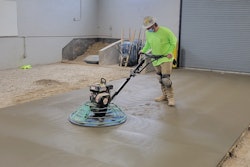
Since it was introduced in the 1970s, F-numbers have proven to be useful in measuring and improving concrete floor flatness and levelness.
With modern finishing equipment, achieving overall floor flatness and levelness has made it easy for flatwork finishers.
F-number measurements are standardized under ASTM E 1155 “Standard Test Method for Determining FF Floor Flatness and FL Floor Levelness Numbers” and the ACI 302.1R-04 “Guide for Concrete Floor and Slab Construction” provides F-number recommendations for hard-troweled slabs-on-ground and suspended slab surfaces.
FF/FL Numbers
Floor flatness (FF) controls the bumpiness of the floor surface and is primarily affected by the finishing operations after screeding, including restraightening and power floating. Essentially, FF numbers evaluate the elevation differences along a sample line at one-foot intervals. F numbers extend from zero to infinity so the higher the F number, the flatter the floor.Floor levelness (FL) controls the departure of the floor surface from the specified slope or plane of the surface. FL numbers evaluate the elevation differences along a sample line at 10-foot intervals. The higher the FL number, the more level the floor.
Levelness of the edge forms and the accuracy of the concrete screeding operation control the overall levelness of the floor. A self-propelled, laser-guided screed can routinely create FL numbers of about 35 and higher.
FF/FL numbers have the following floor flatness classifications:
- FF 25/ FL 20 – moderately flat
- FF 35/ FL 25 – flat
- FF 45/ FL 35 – very flat
- FF 60/ FL 40 – super flat
When Should you Measure FF/FL?
A word of caution, FF/FL numbers diminish with time due to concrete shrinkage and slab curling.With the passage of time, joints and cracks curl making the floor less flat. Therefore, flatness and levelness should be measured as soon as possible, preferably within 24-hours after concrete placement but no later than 72 hours.
If you are unable to make a measurement within the specified time frame, FF and FL numbers may not represent the true performance of your work.
Routinely placing very flat and super flat floors requires an understanding of floor flatness and how to properly use the equipment.
More importantly, it requires practice and continuous self-evaluation.
Always review your FF/FL numbers and critique your placing and finishing techniques. Then make adjustments and improve on your next placement.
Ed. Note: To read previous articles on this topic, visit www.ForConstructionPros.com.
References
ACI 117-10 Specifications for Tolerances for Concrete Construction, American Concrete Institute, www.concrete.org.
ACI 302.1R-04 Guide for Concrete Floor and Slab Construction, American Concrete Institute, www.concrete.org.
This article was originally published on August 13, 2015.



















